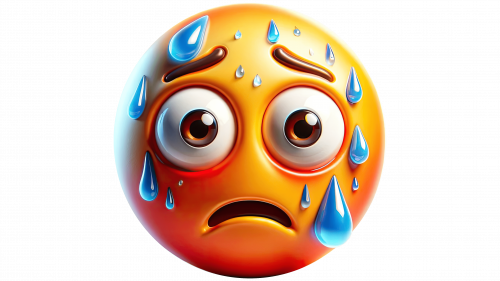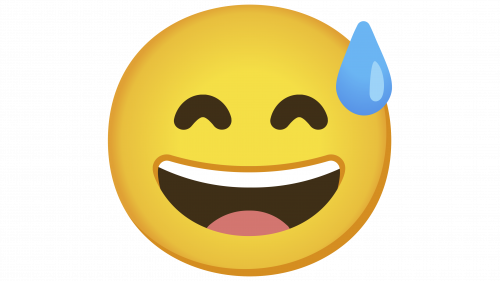Understanding the Sweating Emoji is not straightforward. The drawing depicts a person with sweat dripping from their forehead. However, the character is not upset or strained but is smiling joyfully and even laughing. Therefore, the image is confusing.
The symbol was included in Unicode 6.0 in 2010 under the code U+1F605. It appears in messages as a sign of joy but with slight nuances.
Meaning and use of the Sweating Emoji
A person sweats in several cases. Primarily when they are simply hot, it’s sunny outside, or the clothing is not suitable for the weather. Hence the perspiration on the forehead. Active sports or physical labor also cause sweating. However, the Sweating Emoji is not suffering from heat or falling from exhaustion. Therefore, the image tells of a different kind of sweat.
A person can sweat not only from physical exertion. Strong emotions also lead to “moisture.” Anxiety causes sweat to pour down, clothes become covered with wet spots, and sweating is about this. Fear, terror, shock, or excessive merriment change hormone levels and manifest as perspiration.
- A person who bursts into laughter and cannot stop fits this image: “Oh, don’t make me laugh,” “Laughed until tears.” People also laugh after a survived nightmare when the ordeal is behind them: “Remember how he grabbed you? I was just stunned with horror. And your face was like this! 😅”.
- Intense anxiety leads to a state of shock. For example, he’s a spy about to be exposed. Others will soon understand the shameful truth. Or maybe the car brakes failed, or the train derailed. All this makes the heart beat wildly, and nerves are stretched to the limit. And then, when the danger passes, the exciting performance ends, the driver and passengers remain alive, and blissful relaxation comes: “Phew, that was close. I thought we were goners.” In such a message, the Sweating Emoji is perfectly placed. The sign conveys joy and relief.
One interpretation of the drawing is a joy from the successful completion of work that took a lot of strength and nerves. And finally, like a “weight off the shoulders” – the finale.
The smiley is an attempt to react to stress adequately. To maintain calmness and inner balance. “Keep face”. However, the drawing betrays titanic internal efforts, appearing as a treacherous drop of sweat on the forehead.
Today, there are three emojis that have a hint of a drop of sweat:
😓Downcast Face With Sweat Emoji
The “downcast face with sweat” emoji 😓 is a digital icon that features a face showing a look of sadness or exhaustion, with a noticeable drop of sweat on the forehead. This emoji stands out due to its ability to express various emotions in a visually succinct manner.
Primarily, the 😓 emoji serves to convey emotions like stress or concern. It’s often the go-to symbol for expressing a sense of relief following a narrow escape from a challenging situation. Furthermore, it encapsulates feelings of physical tiredness or the discomfort one might feel in awkward or uneasy scenarios. This versatility makes it a popular choice in digital communication for conveying complex emotions with simplicity.
Text Examples:
- “I just barely met the deadline at work 😓. That was too close for comfort 😰.” Used here to express relief mixed with residual stress over a narrowly-met deadline.
- “Ugh, I left my phone at home today; what a day 😓.” Conveys frustration and the inconvenience of forgetting something important.
- “I can’t believe I sent that text to the wrong person 😓😱.” Illustrates a mix of embarrassment and shock, a common mishap in the digital age.
- “Just finished a 10k run and I’m totally wiped out 😓🏃♂️.” Shows physical exhaustion after a significant athletic effort.
- “The interview was so intense, glad it’s over 😓👔.” Used to express relief and stress after experiencing a high-pressure situation.
😅 Grinning Face With Sweat Emoji
The “grinning face with sweat” emoji 😅 features a wide, open-mouthed smile accompanied by a single sweat droplet on the forehead. This emoji is distinct in its portrayal of mixed emotions, capturing a blend of positivity and stress.
The 😅 emoji is widely used to express a combination of nervousness and relief, particularly in situations that have just been narrowly resolved. It’s apt for moments where someone wants to acknowledge a mistake or a tense situation humorously. This emoji adeptly conveys a sense of awkwardness, often in scenarios where the person is trying to lighten the mood or brush off a potentially embarrassing moment.
Text Examples:
- “Just finished my presentation in front of the whole class, I’m relieved it’s over! 😅👨🏫”. Expresses relief and satisfaction after completing a nerve-wracking task.
- “Phew, I thought I sent that text to the wrong person! 😅📱”. Conveys a sense of relief after avoiding a potentially awkward situation.
- “Managed to catch the bus at the last second 😅🚌.” Illustrates relief and a bit of self-amusement over a close call.
- “When you walk into the wrong room but play it cool 😅😎.” Depicts a mix of humor and embarrassment in an awkward situation.
- “I laughed off the trip, but my heart was racing! 😅💓”. Shows how one might use humor to cover up their nervousness or embarrassment.
😰 Anxious Face With Sweat Emoji
The “anxious face with sweat” emoji 😰 portrays a face with deeply furrowed brows, a distinctly worried look, and a single sweat droplet, typically on one side. This emoji is unique in its ability to vividly convey a sense of deep anxiety or fear, often enhanced by a blue hue on the upper face to symbolize a cold sweat.
The 😰 emoji is commonly used to express feelings of anxiety, nervousness, or intense stress about a specific situation. It’s particularly effective in communicating the emotional state of being on edge or in a state of apprehension. Additionally, it can signify a sense of relief after narrowly escaping an unpleasant or stressful situation, although the primary focus remains on the anxiety experienced.
Text Examples:
- “I think I left the oven on at home 😰 this is really not good!”. Conveys a high level of anxiety over a potentially dangerous oversight.
- “Waiting for the exam results is killing me 😰📚”. Expresses intense nervousness and anticipation regarding an important outcome.
- “I’m running late for the meeting; traffic is a nightmare 😰🚗.” Illustrates stress and worry about being late due to circumstances beyond control.
- “Just heard a noise downstairs while home alone 😰🏠.” Portrays fear and anxiety about a potentially scary or dangerous situation.
- “They’re announcing the layoffs today, feeling super nervous 😰🙏.” Captures the distress and apprehension faced during uncertain and challenging times.
Final thoughts
The emotions conveyed by the Sweating Emoji are said to be “both funny and sad.” A person has found themselves in an unpleasant, dangerous, or painful situation, but at the same time, everything looks so funny. From the outside or looking back at the experience, it’s impossible not to laugh. Most often, fortunately, the danger has already passed, and everything is fine. Therefore, the emoji cannot be called negative. On the contrary, everything could have been much worse, but luckily, it turned out well.
It’s appropriate to send the symbol when you’re talking about your blunder, silly mistake, or embarrassing moment. The sign also fits as a response to a similar message. After the events, the person hasn’t lost the ability to laugh at themselves. Remembering, they understand the entire comedic nature of the situation and how ridiculous it all looked from the outside. This is the duality of the Sweating Emoji. Yes, a strong shock was experienced. But now it’s possible to laugh about it.
Send the smiley after reconciliation and conflict resolution as a message: “I’m glad you’re not mad anymore” or “Thank God we finally understand each other.”







